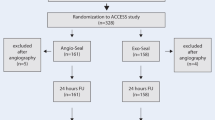Abstract
Purpose
To report our experience of selectively augmenting the preclose technique for percutaneous endovascular aneurysm repair (p-EVAR) with an Angio-Seal device as a haemostatic adjunct in cases of significant bleeding after tensioning the sutures of the suture-mediated closure devices.
Materials and Methods
Prospectively collected data for p-EVAR patients at our institute were analysed. Outcomes included technical success and access site complications. A logistic regression model was used to analyse the effects of sheath size, CFA features and stent graft type on primary failure of the preclose technique necessitating augmentation and also on the development of complications.
Results
p-EVAR was attempted via 122 CFA access sites with a median sheath size of 18-French (range 12- to 28-French). Primary success of the preclose technique was 75.4 % (92/122). Angio-Seal augmentation was utilised as an adjunct to the preclose technique in 20.5 % (25/122). The overall p-EVAR success rate was 95.1 % (116/122). There was a statistically significant relationship (p = 0.0093) between depth of CFA and primary failure of preclose technique. CFA diameter, calcification, type of stent graft and sheath size did not have significant effects on primary preclose technique failure. Overall 4.9 % (6/122) required surgical conversion but otherwise there were no major complications.
Conclusion
Augmentation with an Angio-Seal device is a safe and effective adjunct to increase the success rate of the preclose technique in p-EVAR.

Similar content being viewed by others
References
Greenhalgh RM, Brown LC, Kwong GP, EVAR trial participants et al (2004) Comparison of endovascular aneurysm repair with open repair in patients with abdominal aortic aneurysm (EVAR trial 1), 30-day operative mortality results: randomised controlled trial. Lancet 364:843–848
Prinssen M, Verhoeven EL, Buth J et al (2004) A randomized trial comparing conventional and endovascular repair of abdominal aortic aneurysms. N Engl J Med 351:1607–1618
Malkawi AH, Hinchliffe RJ, Holt PJ, Loftus IM, Thompson MM (2010) Percutaneous access for endovascular aneurysm repair: a systematic review. Eur J Vasc Endovasc Surg 39:676–682
Jean-Baptiste E, Hassen-Khodja R, Haudebourg P, Bouillanne PJ, Declemy S, Batt M (2008) Percutaneous closure devices for endovascular repair of infrarenal abdominal aortic aneurysms: a prospective, non-randomized comparative study. Eur J Vasc Endovasc Surg 35(4):422e8
Howell M, Doughtery K, Strickman N, Krajcer Z (2002) Percutaneous repair of abdominal aortic aneurysms using the AneuRx stent graft and the percutaneous vascular surgery device. Catheter Cardiovasc Interv 55(3):281e7
Torsello GB, Kasprzak B, Klenk E, Tessarek J, Osada N, Torsello GF (2003) Endovascular suture versus cutdown for endovascular aneurysm repair: a prospective randomized pilot study. J Vasc Surg 38(1):78e82
Lee WA, Brown M, Nelson PR, Huber TS (2007) Total percutaneous access for endovascular aortic aneurysm repair (“Preclose” technique). J Vasc Surg 45(6):1095–1101
Dosluoglu HH, Cherr GS, Harris LM, Dryjski ML (2007) Total percutaneous endovascular repair of abdominal aortic aneurysms using Perclose ProGlide closure devices. J Endovasc Ther 14(2):184e8
Lee WA, Brown MP, Nelson PR, Huber TS, Seeger JM (2008) Midterm outcomes of femoral arteries after percutaneous endovascular aortic repair using the Preclose technique. J Vasc Surg 47(5):919e23
Nelson PR, Kracjer Z, Kansal N et al (2014) A multicenter, randomized, controlled trial of totally percutaneous access versus open femoral exposure for endovascular aortic aneurysm repair (the PEVAR trial). J Vasc Surg 59(5):1181–1193
Jaffan AA, Prince EA, Hampson CO, Murphy TP (2013) The Preclose Technique in percutaneous endovascular aortic repair: a systematic literature review and meta-analysis. Cardiovasc Interv Radiol 36:567–577
Hogg ME, Kibbe MR (2006) Percutaneous thoracic and abdominal aortic aneurysm repair: techniques and outcomes. Vascular 14:270–281
Morasch MD (2005) Percutaneous thoracic and abdominal aortic aneurysm repair. Ann Vasc Surg 19:585–589
Smith ST, Timaran CH, Valentine RJ, Rosero EB, Clagett GP, Arko FR (2009) Percutaneous access for endovascular abdominal aortic aneurysm repair: can selection criteria be expanded? Ann Vasc Surg 23:621–626
Sacks D, McClenny TE, Cardella JF, Lewis CA (2003) Society of interventional radiology clinical practice guidelines. J Vasc Interv Radiol 14:S199–S202
Sarin SN, Shah RK, Chun A et al (2012) Use of the 8-F angio-seal vascular closure device in large-caliber arteriotomies. J Endovasc Ther 19(4):497–500
Bechara CF, Barshes NR, Pisimisis G, Chen H, Pak T, Lin PH, Kougias P (2013) Predicting the learning curve and failures of total percutaneous endovascular aortic aneurysm repair. J Vasc Surg 57(1):72–76
Howell M, Villareal R, Krajcer Z (2001) Percutaneous access and closure of femoral artery access sites associated with endoluminal repair of abdominal aortic aneurysms. J Endovasc Ther 8(1):68–74
Borner G, Ivancev K, Sonesson B, Lindblad B, Griffin D, Malina M (2004) Percutaneous AAA repair: is it safe? J Endovasc Ther 11(6):621e6
Morasch MD, Kibbe MR, Evans ME, Meadows WS, Eskandari MK, Matsumura JS et al (2004) Percutaneous repair of abdominal aortic aneurysm. J Vasc Surg 40(1):12e6
Conflict of interest
The authors declare that they have no conflict of interest.
Statement of Informed Consent
Informed consent was obtained from all the patients included in this report.
Author information
Authors and Affiliations
Corresponding author
Appendices
Appendix
Society of Interventional Radiology Clinical Practice Guidelines classification of complications by outcome [15].
Minor Complications
-
A.
No therapy, no consequence
-
B.
Nominal therapy, no consequence; includes overnight admission (less then 23 h) for observation only
Major Complications
-
A.
Require therapy, minor hospitalisation (more then 24 h but less then 48 h)
-
B.
Require major therapy, unplanned increase in level of care, prolonged hospitalisation (more then 48 h)
-
C.
Cause permanent adverse sequelae
-
D.
Result in death.
Rights and permissions
About this article
Cite this article
Patel, R., Juszczak, M.T., Bratby, M.J. et al. Efficacy and Safety of Augmenting the Preclose Technique with a Collagen-Based Closure Device for Percutaneous Endovascular Aneurysm Repair. Cardiovasc Intervent Radiol 38, 821–826 (2015). https://doi.org/10.1007/s00270-014-1004-0
Received:
Accepted:
Published:
Issue Date:
DOI: https://doi.org/10.1007/s00270-014-1004-0




